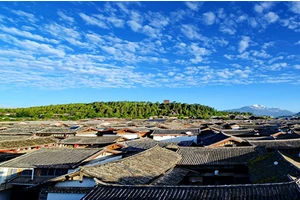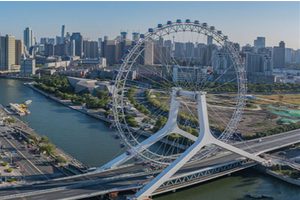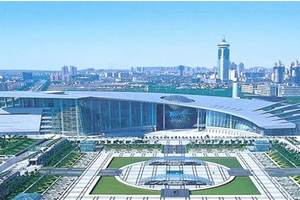Sightseeing line
Introduction of Zhengzhou sightseeing first-line bus route
1. Overview
Sightseeing first-line bus is a series of tourist bus lines in Zhengzhou, with a total length of about 42.5 kilometers and 29 stops, covering the main tourist attractions in Zhengzhou, making it a convenient choice for tourists to travel.
Step 2: Route
The starting point of the first-line sightseeing bus is located in Zhengzhou Railway Station, passing through the Summer Palace, Yellow River levee, Jungong Road business circle, Zhengzhou East Station, Erqi wanda plaza and other places to reach the end point-Century Happy Garden.
3. Highlight attractions
Sightseeing first-line bus routes pass through many scenic spots in the city, including the ancient Songshan Shaolin Temple, the historic Henan Museum, the modern Zhengzhou East Station and the Summer Palace with double glass platforms. There are also the famous Baotu Spring and the Yellow River Embankment, which allow visitors to fully feel the culture and history of Zhengzhou.
4. Bus service
The frequency of sightseeing first-line buses is relatively dense, about every 15 minutes, which is convenient for tourists to travel and can make full use of time. There is air conditioning in the bus, and the seats are more comfortable, which will not make passengers feel tired during the long journey.
5. expenses
The fare of the first-line sightseeing bus is 8 yuan/person, and the whole journey takes about one and a half hours. Passengers can buy tickets directly in the car or through electronic channels such as WeChat. In addition, for the elderly, the disabled and people with Zhengzhou citizen cards, although they need to swipe their cards to enter the station, the bus is free.
6. Tips
As the first-line sightseeing bus is a tourist route, it is necessary to pay attention to safety during tourists' travel and abide by traffic rules and in-vehicle management regulations. In addition, because there are many scenic spots along the way, it is suggested that passengers arrange their time and choose several scenic spots they are interested in to visit, so as to fully experience the beautiful scenery and customs of Zhengzhou.
Step 7 summarize
The first-line sightseeing bus in Zhengzhou can provide tourists with convenient, economical and safe travel options, and the loop route allows tourists to easily visit the tourist attractions in Zhengzhou. As the representative of the future city, Zhengzhou is rich in history and culture, and it also shows the modern city features. I believe this sightseeing route will definitely leave beautiful memories for tourists.
Altay region is rich in tourism resources and has great potential for development and utilization.
I. Overview of Tourism Resources
According to the national standard "Classification, Investigation and Evaluation of Tourism Resources" (GB/T18972-2003), the tourism resources in Altay region are divided into 8 main categories, 31 subcategories and 80 basic types. The main types, sub-types and basic types of tourism resources in Altay region account for 100%, 83.87% and 51.61% of the national tourism resources types respectively. The subcategory of tourism resources representing macro-structure belongs to the rich level, and the basic type of tourism resources representing the fine level belongs to the upper-middle level.
1. Overall evaluation of tourism resources
Altay region has superior tourism resources. There are 2 national nature reserves, 4 land open ports, grassland historical and cultural heritage represented by Altai Mountain rock paintings, Mongolian Tuwa culture and so on. It has the resource conditions to build a world-class and national tourism destination.
1) Natural tourism resources with world-class taste. The alpine scenery, glaciers, snow ridges, lakes, hot springs and rare wild animals and plants in Altay Mountain area, represented by Kanas, have the resource conditions and foundation to develop Altay area into a national tourism attractive tourism product.
2) Historical and cultural tourism resources are unique. The rock paintings, stone carvings, ancient sarcophagus tombs and rich grassland cultural customs in Altay region have unique regional characteristics.
3) The special landform formed in the arid natural environment in the south of Altay region constitutes the foundation of landscape tourism resources. The landscape of Gurbantonggut desert is typical of Yadan landform of colorful city in Fuyun County, which developed in arid environment.
4) Have the conditions to carry out wildlife sightseeing. The flat and vast Junggar Basin and Kalamaili ungulate nature reserve are important habitats for wild animals and have favorable conditions for developing characteristic sightseeing. Beaver Nature Reserve located in qing he, Altay region, is the only beaver nature reserve in China. Beaver, a rare animal in the world, is known as "living fossil".
The evaluation of 339 tourism resources in Altay shows that four of them have reached the best level, namely Kanas Lake, Cocoto Sea, Irtysh River and No.3 Mine, accounting for 1.18% of the survey; There are 179 excellent grades, accounting for 25.80%; There are 160 ordinary classes, accounting for 47.20%. The level of tourism resources is relatively high.
2. Evaluation of tourism resources by type
According to seven kinds of tourism resources, such as eco-tourism resources, border tourism resources and scientific research popular science tourism resources, the evaluation was carried out.
(1) Eco-tourism resources are abundant
Altay, Xinjiang has Kanas Nature Reserve at the national level, ungulates in Kalamaili Mountain at the autonomous region level, Burgen Beaver Nature Reserve at the autonomous region level, Quintas Grassland Nature Reserve, Kekesu Wetland Nature Reserve and Liangheyuan Natural Ecological Reserve.
Kanas Nature Reserve is a comprehensive nature reserve, covering an area of 558,800 hectares. Its main protection targets are Siberian flora and natural landscape. Kanas Lake Scenic Area includes Kanas Lake, Shuanghu Qianhu Lake, Youyifeng Glacier, Baihaba Village and Hemu Hanas Village, three Tuwa primitive villages. Kanas is a scenic spot with the strongest attraction, the highest taste and the best combination in Altay region, and it is also a brand tourism resource in Altay region. The original ecological environment of the valley forest from Keketuohai in Fuyun County to the source of Irtysh River, Diequan Valley in Fuhai County and Alashan Hot Springs is typical, which has the conditions for developing eco-tourism.
(2) Altay region has unique conditions for transnational tourism and border trade tourism in border minority areas.
In recent years, the frontier tourism resources in Altay region have been gradually developed and utilized. Altay region borders Russia and Mongolia in the northeast and Kazakhstan in the west, which has a good geographical advantage. The six counties and one city under its jurisdiction are all open cities and counties, and there are four ports open to the outside world, which has initially formed the embryonic form of border trade tourism development. Kanas Port, the only port in western China that can be directly opened to Russia, is under planning and construction.
Generally speaking, land border ports have two functions: one is political and military function, and the other is economic and cultural exchange function. The economic and cultural exchange function of China's land border is in a dominant position at this stage. There are 12 nature reserves in the Altai region in China, Russia, Mongolia and Kazakhstan, among which one in Russia is applying for world natural heritage. The cooperation and joint development of the "four countries and six parties" in Altai region is conducive to the development of transnational tourism and border trade tourism.
(3) The grassland nomadic cultural tourism resources are abundant.
The grassland culture in Altai region, represented by rock paintings, stone figures, ancient tombs, deer stones, the "Grassland Silk Road" and "golden road", is well-known at home and abroad. There are mainly Sandaozizi Stone Grave in qing he, Shibakule Deer Stone, Tuluke Rock Painting, Kiriko Ercek Tomb in Altay City, Dorate Rock Painting, Tangbala Rock Painting in Fuyun County, Supt Stone Man, and many other rock painting resources, which are called ".
(4) There are abundant special and special tourism resources such as scientific exploration and popular science education.
Altay region is rich in special tourism resources, among which Kanas Taigarin, Youyi Peak, Keketuohai mining area, Fuyun earthquake fault zone, silicified wood, dinosaur fossils and exploring the source of Irtysh River are all important special tourism resources. Among them, the Keketuohai No.3 vein in Fuyun County has typical geological and metallogenic conditions and is known as the "World Museum of Geology and Minerals". Up to now, 86 minerals (including subspecies) such as lithium, beryllium, tantalum and niobium have been found in this vein, which is unique in China and rare in the world, and has great geological significance.
(5) The frontier ethnic customs are rich in tourism resources.
Altay region is a place where many nationalities gather, including Kazak, Han, Russia and other 13 nationalities, with rich ethnic customs and profound national culture. There are three ethnic villages near Kanas in the region, which are little influenced by modern people. Tuwa people and Kazakh herders live there and have unique ethnic characteristics. From Habahe County to Ahetubek, there is a unique frontier scenery and ethnic customs. Hongshanzui Port in Fuhai County has been closed for four months in winter due to heavy snow, and the conditions are extremely difficult. The Hongshan Mouth Guard Station here is one of the most difficult border posts in China, and is known as the "Snow Mountain Island".
(6) Precious stones, strange stones and other products are abundant.
The gems in Altay region are famous all over the country. Altay City, Fuyun County and Fuhai County are rich in many kinds of precious stones, including 9 categories and 21 species, among which aquamarine, tourmaline and purple tooth tungsten are the most famous. Fuyun and Habahe counties are two counties of gold. In addition, there are many strange stones in the Irtysh River valley in Fuyun County, which are good raw materials for handicrafts. All these are important shopping tourism resources in Altay region, which can develop high-grade tourism commodities.
(7) Excellent conditions for ice and snow tourism in winter.
Altay region has the unique ice and snow resources to carry out winter tourism, which is the best area to develop ski tourism in the west, and has the resource conditions and advantages to build a ski sports base in the west of China. The Altai Mountains are characterized by diverse forms, broad, moderate slopes, good terrain, good environment, suitable altitude and temperature, etc. The wind is small in winter, and there are glaciers and snow ridges all year round. The average winter temperature in Altay region is 0 ~ 2℃, and the temperature is low, and the winter is long. In normal years, snow falls in the middle of October every year, and the snow begins to melt in the middle of April the following year, which is 20 ~ 30 days earlier than that in the northeast of China. At present, an international brand with "the earliest origin of human skiing" has been initially formed, and a series of Altay winter tourist routes and tourism activities have been developed and launched. Four consecutive ice and snow tourism activities have been successfully held, and various national alpine skiing competitions and ancient wool snowboarding competitions have been held.
Second, the current situation of tourism development
In recent years, under the guidance of the national industrial policy, the tourism industry in Altay region has been highly valued by the leading departments at all levels in the autonomous region and the region. Each county and city has set up tourism bureaus and hired experts to carry out regional and county-level tourism development and layout planning. Altay region has invested a lot in tourism development in Kanas Lake, Xiaodonggou Forest Park, Alashan Hot Springs and Wulungu Lake in Fuhai County. For example, the tourism project of Kanas Scenic Area was listed as a key construction project by the Planning Commission of the Autonomous Region in 2000, with a total investment of 89 million yuan.
By the end of 2012, there were two national geoparks in Altay, namely Kanas National Geopark and Cocotohai National Geopark in Fuyun County. There are 2 national forest parks, namely Jiadengyu and Baihaba National Forest Park. There are 5 forest parks at the autonomous region level, namely Beitun, Fuyun Donggou, Jinshan Forest Park, Hualin Park and Raster Donggou. There are 2 national nature reserves, Kanas and Karamaili ungulates national nature reserves. There are 4 autonomous regions, namely Kosu Wetland, Two Rivers, Quintas Grassland and Bourgen Beaver Nature Reserve. There are 2 state-level cultural relics protection units, namely, Erqieke Stone Tomb Group in Kiriko, Altay City, qing he Sandaohaizi Deer Stone Tomb Group, 15 at the autonomous region level, and 54 at the county (city) level. There are 6 national industrial and agricultural tourism demonstration sites.
The city has 13 A-level scenic spots, 4 national agricultural tourism demonstration sites, 197 agricultural (animal husbandry) hotels, 27 tourist hotels and 7 star-rated hotels, with a daily reception capacity of more than 4,000 people. There are 2 tour companies, 2 tour convoys, 25 travel agencies, 105 tourist shops, more than 500 special restaurants, 3 S-class ski resorts and more than 4,000 people in tourism professionals.
In recent years, Altay region has launched a series of publicity activities, such as Summer of Jinshan, Ice and Snow Scenery Tour, with the help of Wuqi Fair, Winter Expo and other publicity and promotion platforms, as well as inviting mainstream media inside and outside the region to collect views, and other tourism brands such as "Golden Mountain Silver Water", "Kazak Folk Culture Concentrated Performance Place", "The earliest origin of human skiing" and "Kanas Tourism Distribution Center" in Xinjiang and even the whole country.
In 2012, the Altay region received a total of 4.75 million domestic and foreign tourists, up 19.5% over the previous year, and realized a tourism income of 3.585 billion yuan, up 20.22%. Among them, Kanas Scenic Area received 632,900 tourists and realized a tourism income of 890 million yuan.
The tourism industry in Altay has developed rapidly. In 2012, the number of tourists and tourism income were 6.85 times and 14.20 times that of 2002 respectively. The number of tourists and tourism income in Kanas Scenic Area in 2005 were 1.11 times and 2.02 times that in 2012, respectively (Table 6-21).
Table 6-21 Changes of Tourist Numbers and Income in Altay Region from 2002 to 2012
Iii. Problems and Suggestions in Tourism Development
(A) There are repeated constructions of tourism resources in Altay, and there is a tendency of homogenization in the development of tourism resources.
There are low-level and repeated development and construction problems in the development of tourism resources in Altay area and cities and counties, and there is a tendency of homogenization in the development of tourism resources. For example, the development of tourism resources such as Kanas Scenic Area and Halonggou Scenic Area in Cocoto Sea Scenic Area should clarify their different functional orientations. The status and taste of Cocoto Sea Scenic Area should be further improved to promote the tourism development in the eastern region. Haronggou Scenic Area combines the development trend of western tourism with Kanas Scenic Area as the leader, promotes its own development orientation, and forms a pattern of collaborative development with Kanas Scenic Area.
In order to actively respond to the transformation of tourism resources development mode in Altay region, it is necessary to scientifically analyze the target tourist market, analyze the advantages and disadvantages of tourism development and its competitiveness with homogeneous tourist destinations, so as to form a competitive tourism product system for differentiated target markets, realize differentiated development policies in different cities, counties and major scenic spots, strengthen division of labor and cooperation, and jointly create all-season tourist destinations in Altay region.
(2) The overall tourism pattern in Altay region has not yet formed, and the tourism development model needs to be adjusted to optimize the tourism spatial pattern.
The development of tourism in Altay region has changed from unipolar to multipolar, but there are some deviations in the overall thinking of tourism development and the big tourism pattern has not yet formed.
The regional tourism development model needs to be adjusted and optimized urgently. The current tourism resources development models in Altay region are mainly resource-oriented, market-oriented and product-oriented, and should be adjusted to image-oriented and industry-oriented in the future.
Altay region should enter the stage of building a regional tourism destination as soon as possible, build the whole region as a tourism destination, shape the overall tourism image and promote unified marketing.
From the perspective of shaping the tourism pattern in Altay region, we should change the limitation of the unique "polar core development model" in Kanas scenic spot, develop the "point-axis development model", and promote the formation of the overall tourism pattern in Altay region. According to the overall development trend of tourism industry in Altay region, the core scenic spots should be scientifically determined, with Kanas and Keketuohai as the leaders and Sandaozhaizi, Wuzhi Springs, Alashan Hot Springs, Wulungu Lake, Halonggou, Baisha Lake, Shenshicheng and other key scenic spots playing a leading role. The development spatial pattern is formed by the tourism development axes such as National Highway 216 and National Highway 217, Altai Cultural Axis, Ertix River Scenery Axis and Northwest Frontier Tour Axis. Through the core scenic spots and key scenic spots and the axis of tourism development, several scenic spots will be driven to adjust and optimize the spatial pattern of tourism in Altay region.
(C) There is a contradiction between extensive development and insufficiency in the development of tourism resources in Altay region, and the development degree of tourism products is low and the structure is single.
By the end of 2009, some high-quality tourism resources in Altay were extensively developed and idle. For example, Coco Tuohai Scenic Area, the development of tourism resources is relatively insufficient, and the development of scenic spots does not meet the big market demand. Tourism products mainly focus on sightseeing, with insufficient market influence, and a diversified and competitive tourism product system has not yet been formed.
The development of high-quality tourism resources such as Sandaohaizi, Shenshicheng, Alashan Hot Springs and Halonggou is seriously insufficient, and even some tourism resources are idle.
Tourism products in Altay are mainly sightseeing products, while leisure and holiday tourism products are relatively insufficient, resulting in a single structure of tourism products. The main tourism resources in Altay region are ecological, special and cultural tourism resources, among which the focus of development is sightseeing, and only a few leisure tourism and holiday tourism products have been developed, which can no longer meet the demand of domestic and foreign tourism markets for tourism products in Altay region.
(D) Affected by extreme climatic conditions such as the cold climate, and limited by the ideas of tourism development, the market competitiveness is weak, and the development of winter tourism products needs to be strengthened.
Due to the relatively high latitude and altitude, the average temperature in Altay is below 0℃ from November to March of the following year. Due to the cold climate and the decline of tourism landscape conditions, Altay region has been in the off-season for more than six months throughout the year, resulting in idle tourism resources, facilities and human resources for nearly half of the time, and the utilization efficiency of tourism resources is low.
Because Altay region is located in the northwest border, far away from the main tourist market in eastern China, the market competitiveness is relatively weak, and limited by the idea of winter tourism development, the comprehensive advantages of winter tourism resources have not been effectively brought into play. At present, the winter tourism products are mainly single recreational skiing, and the market brand has not yet been established. This has affected the investment in winter tourism to some extent. In the future, under the guidance of global vision, market and business philosophy, we should highlight local culture and reflect Altay characteristics, pay attention to the construction of ecological civilization in tourist areas, gradually strengthen the development of winter tourism products, and promote the healthy and sustainable development of winter tourism industry.
(E) The market competitiveness of tourism in Altay region is relatively weak, and the radiation-driven ability of tourism needs to be strengthened.
First of all, the external objective conditions of tourism development (traffic, location, etc.) constrain the development of tourism. Altay region is located in the northwest border of China, far from the central and eastern core markets, with high tourism cost and poor accessibility. Due to the lack of routes and flights, the connection with tourists around Bohai Sea, Yangtze River Delta and Pearl River Delta and foreign tourists is poor. Tourists in Xinjiang Uygur Autonomous Region mainly rely on highways. Due to the long distance, the long-distance travel time of the main tourist destinations is generally more than 6 hours, resulting in poor accessibility of tourist attractions.
Second, the lack of high-profile tourism brands is one of the main reasons that restrict the competitiveness of tourism development. At present, there is only one tourist brand with national influence in Altay, Kanas Scenic Area. In 2009, Kanas Scenic Area received 682,000 tourists, and realized tourism income of 368 million yuan, accounting for 22.72% and 32.00% of the region respectively, that is, more than 30% of the regional tourism income came from Kanas Scenic Area. However, compared with some large-scale tourist attractions in China, the reception facilities, reception level and reception scale of Kanas scenic spot in 2009 are still at a low level. In recent years, although the scale of tourism environment in Kanas scenic spot has been greatly improved, there is still a gap compared with some domestic tourist attractions. For example, in 2012, Yuntai Mountain Scenic Spot in Jiaozuo, Henan Province received 5.04 million tourists, nearly 8 times that of Kanas Scenic Spot.
Third, limited by the current stage of tourism development, the benefits of tourism need to be improved and the elements of tourism industry need to be improved. At present, the cost of tourism, accommodation and transportation accounts for a relatively large proportion. The extension in catering, shopping and entertainment is not enough, and the proportion of tourists' entertainment and shopping expenses is relatively low. It is suggested to adjust the structure of tourism consumption, reduce accommodation, transportation and tourism consumption cost, and improve the consumption level of catering, shopping and entertainment.
Fourth, the radiation-driven role of tourist cities and scenic spots is relatively limited. Because the tourism development in Altay region is still in the initial stage of development, the existing radiation-driven role of cities and scenic spots is limited, which affects the development effect of eco-tourism, rural tourism and poverty alleviation tourism.
(6) Tourism talents are scarce, and the talent incentive mechanism needs to be improved.
With relatively rich tourism resources and the development of tourism industry, there is a shortage of tourism talents in Altay. This has also become a major obstacle to the development of tourism in Altay. Tourism development needs many fields, such as tourism resource evaluation, tourism project planning, scenic spot development, marketing, tourism commodity development and tourism investment, and talents in administration, enterprise, marketing, service, operation, planning and design. At present, the number and quality of employees at all levels in Altay region are not suitable for the development of regional tourism, so it is urgent to establish an incentive mechanism for tourism talents. Effectively improve the treatment of tourism practitioners, and formulate relevant preferential policies in terms of wages, job promotion and job title evaluation.
(7) The contradiction between tourism and mining development is increasingly prominent, and effective measures are urgently needed to solve it.
With the development of mining economy in Altay region, the contradiction with tourism has become increasingly prominent, mainly reflected in the relationship between mining and tourism on ecological environment protection. How to solve this contradiction is also an important issue for the rapid development of tourism in Altay region.
Human mining activities such as geological and mineral exploration, development and utilization in Altay region have threatened the fragile natural ecological environment in this region, and the contradiction between mining and regional environmental protection has become increasingly prominent. According to the requirements of different functional divisions determined by the overall planning of regional, city and county mineral resources, under the premise of protecting the ecological environment, we will carry out geological and mineral exploration and development activities in an orderly manner. For example, it is forbidden to explore and develop mineral resources in the core areas of natural environmental protection areas, scenic spots and forest parks. Use engineering measures to speed up the treatment of geological environment problems in surrounding mines such as nature reserves.






